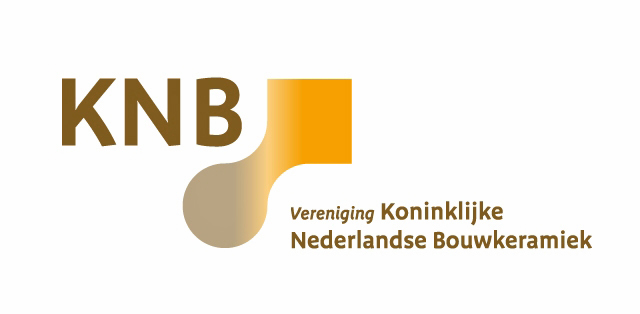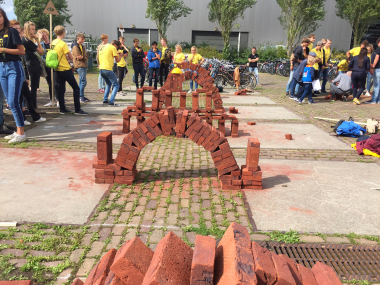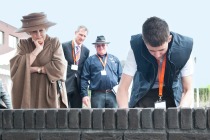02.07.2009 News: Annual report 2008 of the Roayl Association of Dutch Clay Brick Manufactures (KNB)
E. L.J. van Hal, Director KNB
2008 was a year of historical events: an unprecedented high oil price in the spring and in the autumn the financial crisis which spread from North America to Europe. The Dutch clay brick industry could not evade these developments. The sales of facing bricks declined with 8%, mainly as a result of strongly decreased export (-28%). However the sales of paving bricks made history. Never before did the Dutch clay brick industry sell so many paving bricks (+6%). Total sales declined slightly (-1%). The worldwide credit crisis has a big influence on the future expectations for our industry. For the short term there are challenges ahead in the financial and socioeconomic field. For the longer term these are mainly sectoral and are in the field of climate and sustainability. The proven innovation force of the ceramic industry offers a good starting point to face these challenges. Just like the collaboration between manufacturers, which has lasted 125 years in 2009, and jointly because of which the ceramic product has maintained a future.
Sales and market developments
Building market
The growth of 3.6% expected at the beginning of 2008 for the total building market turned out to have been adjusted to 3.25% by the end of 2008. Besides new non-residential building projects, renovation and refurbishment greatly contributed to this growth. In 2008 future expectations for 2009 and the years after had to be adjusted downwards on an almost monthly basis. For the coming years it is expected that the growth of the building sector will greatly reduce.
House building
The number of dwellings completed fell in 2008 with 2% to approx. 79,000. That is a little lower than in 2007, the top year of this young century. The largest fall of this took place in the last quarter of 2008, namely -11% in comparison with the last quarter of 2007. The number of apartments within the completed new housing rose again. This is regretted by our sector as ground-oriented dwellings use absolutely and relatively more bricks than a non-ground-oriented dwelling.
The number of permits issued for new homes fell slightly in 2008 (-1%). Despite this fall the number of dwellings awaiting completion has increased to more than 184,000. This is an increase of more than 4% in comparison with the end of 2007.
Sales of facing bricks at historical low
The number of facing bricks sold fell in 2008 with 8% in comparison with 2007. This means a fall of 92 million to a record low of 1,063 million. The export of Dutch facing bricks has fallen by more than a quarter to 171 million WF. This export fall is also a result of the decreasing building market in the countries surrounding the Netherlands.
The total national sales of facing bricks fell by 2%. This fall is entirely borne by the Dutch facing brick and is in line with the number of completions in 2008 (-2%).
Sales of clay pavers at historic high
The rising trend in the sales of paving bricks since the beginning of this century continued in the year under review. These sales rose with 6% to an all time high of 384 million WF.
Of this almost 35 milion WF was delivered as packages for mechanised paving. A good result as the new development of mechanised paving is requiring large adaptations in factories.
Prospects
The prospects for the sales of facing bricks for the next years are difficult to estimate due to the current economic situation. A decline in the housing market is expected in 2009 of at least 10% and another 10% in 2010. This is expected to take place mainly in the home-buying sector. For now it is expected that the sales of facing bricks will fall in 2010 to below 900 million WF. However the future for the coming years is highly uncertain, which means that these sales predictions are also surrounded by a high degree of inaccuracy.
Environmental Issues
The production of bricks requires raw materials (clay and energy) and viewed in this light has a possible influence on the worldwide climate. However, the Dutch clay brick industry makes far-reaching contributions to the reduction of this possible effect. It makes a structural effort to save energy and reduce CO2 emissions.
Emission Trade System
From 2008 the majority of the Dutch clay brick industry takes part in the European CO2 emission trade. From the monitoring of production year 2008 it appears that the emission space allocated to the Dutch clay brick industry agrees with that in practice.
The clay brick industry deems emission trade the most cost efficient reduction measure, despite this being a substantial administrative burden for individual companies.
Besides the monitoring of and reporting on CO2 emissions by individual companies an independent verification is also carried out. This is another additional administrative and especially costly burden for companies. From 2008 this verification at industry level is optimised meaning that in the coming years this can take place in a systematic and cost efficient manner.
Energy savings
The year 2008 furthermore marks the establishment of a new generation of agreements regarding energy efficiency (MJA3). With the accession the participation since 1993 by the clay brick industry in previous multiple-year agreements is continued and combined with ambitious savings targets for the period up to 2020.
In the past decennia the Dutch clay brick industry substantially improved its energy efficiency by way of applying new energy saving techniques and bringing together productions in the most efficiently producing factories.
Energy saving is possible at factory level but also by improving the efficiency in the chain. And where the clay brick industry is able to contribute to a more sustainable living environment with a more energy efficient product in a comfortable and energy efficient structure, an additional effort is made.
BREF
The Dutch clay brick manufacturers strive to acquire state of the art technology (required by the EC). In 2007 the European Commission set out the level of the state of the art technology for the ceramic industry for the subsequent years. The Dutch government then presented a document in 2008 which serves as a guideline for the various authorised bodies regarding issuing environmental licences. The KNB has shown undiminished willingness to make a cost efficient contribution in achieving various national environmental goals. It has however principal objections against stacking environmental legislation en creating unfair competition. The proportionality principle should always be the starting point for policy. The clay brick industry can therefore not be burdened by achieving all national environmental targets. The Dutch government understood this and was able to introduce the BREF document in a manner acceptable for the industry.
Transfer of Knowledge
For 18 years the KNB has displayed attractive brick architecture through its magazine BAKSTEEN. The 54th edition of BAKSTEEN focused on innovations in the clay brick industry. In this edition it was described how leveraging scale and a different market approach have lead to an increased design freedom in ceramics. Both other editions were focused on new districts and Spain.
The growing social need for insight into aspects of the sustainability of (building) materials lead to the publication ’Baksteen: mooi, duurzaam en milieuverantwoord’ ('Brick: beautiful, sustainable and environmentally friendly'). In this colourful publication the clay brick industry is described as an industry contributing to the Dutch identity with its products and production process. The preface of the Minister of Environmental Affairs emphasised that this story should be heard!
The KNB furthermore arranged a number of other publications, such as an educational letter ‘Baksteen Steengoed’ (Brick is terrific') for primary education, a publication about spanning supporting structures in brick facades, an update of a KNB brochure on CE marking of facing bricks and a digital manual especially developed for teachers and lecturers of bricklaying courses.
A Brick Master Class was organised for architects while for bricklaying and pointing courses a networking day and for teachers working in higher vocational education an information day around brick was organised.
Furthermore the 56th bricklaying and pointing championship was initiated with a large number of regional qualifying rounds.
Of special importance was a symposium on mechanised paving with paving bricks. It concerned a large number of practical demonstrations and lectures. This resulted in an unprecedented turnout and national media interest. The symposium was aimed at promoting the use of paving bricks in public spaces and the improvement of these and to support the mechanised processing of the burnt products.
Innovation and research
With a view to the position of the paving brick research was carried out from which it appeared that paving bricks laid in a herringbone pattern create a measured additional noise of only 2 dB at 30, 40 and 50 km/h. The legal standards could be adjusted as a result of this research.
In collaboration with the Belgian Baksteenfederatie (Clay Brick Federation) the KNB commenced research into brickwork. Central in this is the development of a test with a predictive value for the risk of white deposits on brickwork. Very little is known about this. Follow-up research started in 2007 into the green discoloration of brickwork and was concluded in 2008. The results of the laboratory research however showed insufficient bearing on practice.
The KNB was furthermore involved in handing out to students of the Technical University of Eindhoven the British ‘Manual for Design of Plain Masonry in building structures to Eurocode 6' in the framework of the change over of the curriculum from Dutch into English.
Raw materials
Natura 2000
Natura 2000 is aimed at the establishment of a European network of nature reserves. Existing use should be continued on in principle prudentially acceptable conditions ('feasible and affordable').
Despite intensive lobbying the KNB was eventually less happy with a sector study arranged by the government in the autumn of 2008 by way of a quick scan 'Existing use'. The consultation on area allocation started by the KNB in 2007 with the province of Gelderland and Rijkswaterstaat (Public Works and Water Management) was being continued.
Code of conduct
Following the start in 2007, the 'Federatie van Oppervlakte Delfstofwinnende Industrieën' (FODI, Federation for the Surface Mining of Minerals Industries), of which the KNB is a member, continued in 2008 to work hard on a Code of Conduct 'Zorgvuldig Winnen' (Careful Mining). The voluntary compliance of companies when mining raw materials with the code of conduct approved by the Minister of Agriculture and Nature lightens the administrative burden for the business sector, whilst maintaining the key targets of legislation.
It was not yet possible to benefit from this in the year 2008.
Social affairs
Since 1 January 2007, employers and employees in the clay brick industry carry the responsibility for proper regulations regarding working conditions. This is applicable at company level as well as industry level. Around the middle of 2008 a start was made with setting up regulations for the industry regarding dust, noise, machine safety, physical stress and work place planning. In connection with this the contacts with the labour inspectorate were strengthened.
The European “Social Dialogue Agreement on Workers Health Protection through the Good Handling and Use of Crystalline Silica and Products containing it” (in short SDA Silica) introduced by the KNB to its members at the beginning of 2007 resulted in a number of concrete actions in 2008.
One of these actions meant that individual companies were supported in the compliance with this European agreement. Furthermore a course was made available: ‘Veilig Omgaan met Stof’ (The safe handling of dust). This ensured that KNB members were able to provide their employees with training and education, as required based on the SDA Silica. The course was in great demand and the response was, without exception, very positive. Through the umbrella organisation of national general employers the KNB took the initiative to set up a contact group regarding SDA Silica. The purpose is to establish a network of umbrella organisations aimed at the exchange of data and the provision of information.
An industry wide project regarding the interest of sustainable utilisation of employees with the name ‘Gebakken voor de Toekomst’ (Firing for the Future) was started by the KNB with financial support of the government.
A self-diagnose instrument was developed and a database was made available. Thanks to this project the sector has become more aware of its situation regarding employees and the possibilities offered by a lifecycle conscious personnel policy.
KNB in Detail
The Royal Association of Dutch Clay Brick Manufacturers (KNB) is the umbrella organisation for the Dutch brick industry. It promotes the collective interests of its members in respect of the environment, energy, raw materials and the building trade. In addition KNB develops knowledge on all aspects of brick in the design and processing stages and ensures that this knowledge is transferred and distributed. Finally KNB is active in the fields of economic, social and technical affairs and is party to the Collective Labour Agreement.
Since 1 January 2008, KNB has been collaborating with the General Association for the Dutch Earthenware Industry (AVA) and the Netherlands Ceramic Roof Tile Manufacturers Corporation (NEDACO) within the Foundation for United Ceramic Organisation (VKO).
During the year under review, necessary preparations were taken for the launch of VKO. One of the tasks of VKO, starting in January 2008, is to provide services to the collaborating sector organisations. For all of its day-to-day work, the KNB also therefore calls upon the services of the VKO Office.
The Dutch brick industry has 41 factories and a total workforce of approximately 1,600 people; an annual production of some 1.5 billion bricks; 46 tunnel kilns, 42 flame kilns and 1 ring kiln.
Koninklijk Verbond van Nederlandse Baksteenfabrikanten (KNB)
Florijnweg 6 I 6883 JP Velp-Arnhem IThe Netherlands
T +31 (0) 2 63 84 56 30 I F +31 (0) 2 63 84 56 31
Secretariaat@knb-baksteen.nl Iwww.knb-baksteen.nl




